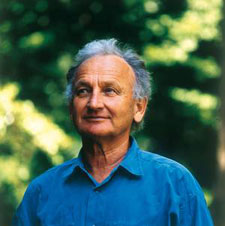
To the death of Günter Behnisch
 |
| photo: Prof. Christian Kandzia |
Günter Behnisch was born on June 12, 1922, in Lockwitz near Dresden. At twelve, his family moved to Chemnitz, and at eighteen (1939), he enlisted in the German army, where he served as a submarine commander until the end of World War II. After the war, he studied architecture in Stuttgart, then briefly worked in Rolf Gutbrod's studio and founded his first architectural office in 1952. In the following years, he built a number of school and sports facilities in Baden-Württemberg. His bold solution for the roof of the Olympic Stadium in Munich (1972) attracted international attention. This project offered not only lightness and playfulness but also a new democratic expression of German architecture, which he continued with the extension of the German Bundestag in Bonn (1990) and the Academy of Arts in Berlin (2005).
Behnisch's projects have one thing in common: the floor plans and expression of the building always stem from internal needs. Function and operations connect to an open core, creating a fragmented and visually transparent space. He broke large volumes into individual surfaces and lines, replacing cumbersome walls with filigree glass facades, breaking the whole into the benefit of diversity.
Throughout his life, Günter Behnisch was traumatized by the ideological misuse of architecture by the Nazis; he felt averse to oppressive stone buildings. The best evidence of his strong humanistic and ecological worldview will remain his buildings. Günter Behnisch died at the age of 88 after a long illness on July 12, 2010, in Stuttgart, Germany.
The English translation is powered by AI tool. Switch to Czech to view the original text source.
0 comments
add comment
Related articles
0
15.02.2024 | To the death of Peter Kulka
0
25.01.2024 | To the death of Heinz Tesár
0
30.12.2022 | To the death of Arata Isozaki
0
04.04.2019 | To the death of Friedrich Achleitner
1
15.04.2012 | To the death of Karljosef Schattner
0
25.02.2012 | To the death of Luise M. Mansilla
1
07.01.2012 | To the death of Ricardo Legorreta











